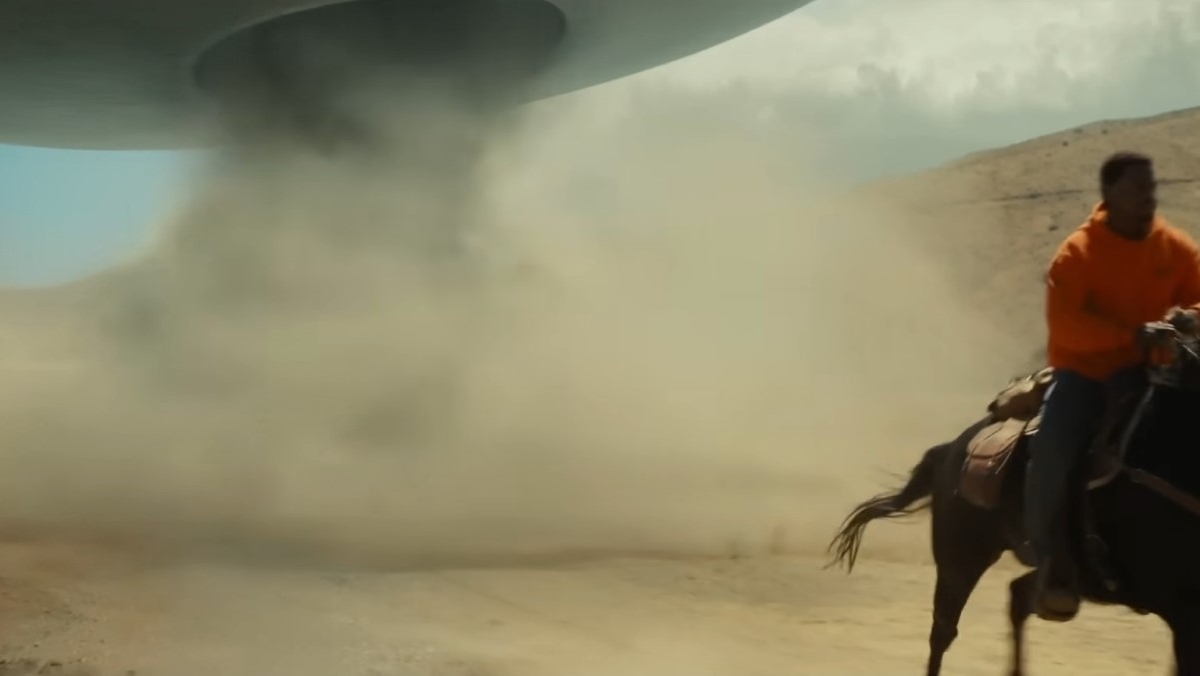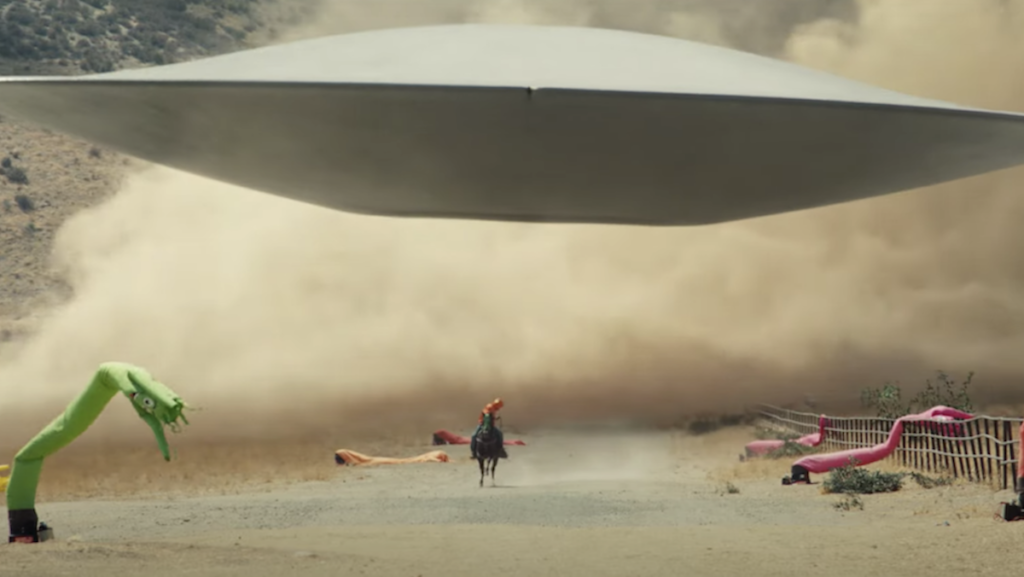Nope may not seem like the kind of movie that needs to consult scientists. And it’s true, they didn’t need to. But the film is better, and scarier, because it did. Kelsi Rutledge, a graduate student at the University of California, Los Angeles, advised Jordan Peele and the rest of the creative team on the design of the alien.
In the upcoming bonus materials, Rutledge becomes a character in the world of Nope. She is the science consultant for OJ, Emerald, and Angel as well. The four will author a scientific paper describing the new species. Nope‘s alien’s scientific name is Occulonimbus edoequus, which translates to “hidden dark cloud stallion-eater.” More on that badass choice in our conversation with Rutledge below.
Nope‘s big flying saucer reveal was that it wasn’t an alien ship at all. Instead, it was a new species of animal. The ship-like form included a mouth that vacuumed up horses and humans as tasty prey. And it didn’t end there. Like nothing we’ve ever seen before, the saucer unfurled like petals opening to the sun. A giant green eye pulsed at Daniel Kaluuya while we all held our breath. But it turns out that people have actually seen things like this alien species before. Earth’s oceans are home to many mysterious animals after all.
Rutledge is the perfect person to announce the new animal from Nope. She studies fish and discovered a new species of guitarfish in 2019. She shared the news in an unconventional way, posting professional photos as if it were a birth announcement. She provided information and graphics of ocean critters that inspired the VFX team’s final design. She shared that slideshow with Nerdist and answered our burning questions about Nope.
Nerdist: What are some of the animals that inspired Nope‘s alien design?
Kelsi Rutledge: Jordan wanted to make something that was still in the realm of scientific possibility. He had a clear vision for how he wanted the creature to look and then was hoping for certain elements. Like, “Is there anything like this that exists?” I think marine animals have freaky, weird attributes that provide great inspiration for alien-like things. When he was designing the eyeball, for example, he’s like, “I really want to do a square eyeball, but does that exist anywhere in nature?” It’s not very common, but octopus have this very square iris actually.
One big inspiration for Jordan was cuttlefish. He wanted the viewer, and the cast members, to be mesmerized by the creature. And so he liked how the cuttlefish attracts prey through a form of hypnosis. But also, these animals and other cephalopods have color changing pigment cells called chromatophores. It gives them this amazing ability to camouflage against any surface. This parallels the ability of Nope‘s creature to camouflage into the clouds.
There’s also this crazy creature called a giant larvacean. This is a digital rendering of the internal geometry. You can see how this looks very similar to the scene where people are being swallowed by the animal.
The VFX really closely modeled the saucer-like form of a sand dollar. On the underside, there’s a similar mouth-like opening as well. The unfurling nature of Nope‘s creature is also similar to how the bluefin tuna can expand and retract its fin. Other elements of fishes, squid, and jellyfish were also used for inspiration, in how they swim and propel themselves through the water.
I think Jean Jacket tries to entice or lure you. Jordan described it as peacocking. This beautiful form is hard not to look at. But if you do, it’ll eat you. I think it highlights how this animal abides by the rules of nature. To me, it felt like the movie had a “we should respect animals” theme. Many of the animals shown predators and we have to follow their rules.
Tell us more about the inspiration behind the scientific name, Occulonimbus edoequus.
Rutledge: When you discover a new species, you have to prove it to the scientific community. You write up a whole paper, you describe the species in exhaustive detail. Then you submit it to a scientific journal and it undergoes the peer review process. You have to follow very specific rules. It has to have specific endings for each category, it has to be Latinized.
I described this creature and all the elements of it. We have a real scientific illustrator who’s illustrated the figures of the creature. We’re writing it as if the characters in the movie discovered it. They’re going to say that they reached out to me at UCLA. And then I wrote it, with all of their help. The authors of this mock manuscript will be the character’s names and then mine. I was very honored. I was so surprised. I don’t know of any other movie that has ever written up a whole scientific manuscript to debut their creature.
We decided that Jean Jacket should be in the animal kingdom. We created a new phylum and every new category from there, because this thing is super different. The phylum is Nubaria, which means “of the clouds.” So hypothetically, if we discover any more creatures that live exclusively in the clouds, it could go into this phylum. Then for the class, we did Oblatozoa. This translates to “oblate-shaped animal.” Order is Suctoforamina, which means “window of suction.” This is specifically for animals that are suction feeding in air. And then the family is Versipellidae, which translates to “shapeshifter.” This comes from the Latin word versipellis, associated with a lot of mythology and folklore.
For the genus and species, which is kind of the most important name for the animal, we decided on Occulonimbus edoequus. Occulonimbus translates to “hidden dark cloud” and then edoequus is “stallion-eater.” We chose that because we thought it sounded really badass and there’s some common words in there that people might recognize. And Jean Jacket would be the common name.

Why is it important that fictional storytelling have a basis in reality?
Rutledge: Most people now are familiar with peer review, hopefully, as we’re in this age of disinformation. But I think having this material shows what goes into describing a new species. Especially the bonus materials, it’s really going to bring to light the importance of a scientific process that maybe the community at large isn’t generally familiar with.
Incorporating scientific advisors into the movie just makes it more realistic. And I think personally that also makes it more scary. I think when you make a movie that has a realistic thread through it, then it’s definitely more scary. So it’s very satisfying as a scientist to watch.
In the movie, they don’t reach out to any scientists. Maybe to their downfall. Right at the beginning, when they see the creature, instead of trying to get the money shot, if they would’ve alerted the authorities, then maybe people wouldn’t have died. If scientists and animal behavior specialists had observed the animal, we could have figured it out sooner.
Thanks to Kelsi Rutledge for her insights about working on Nope. Three other scientific consultants are credited on the movie: John O. Dabiri, Stuart D. Bale, and Justin Kasper. I commend Jordan Peele and his creative team for consulting scientists and incorporating science into this excellent work of fiction. More please!
Melissa is Nerdist’s science & technology staff writer. She also moderates “science of” panels at conventions and co-hosts Star Warsologies, a podcast about science and Star Wars. Follow her on Twitter @melissatruth.

